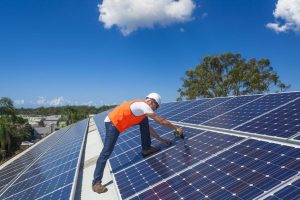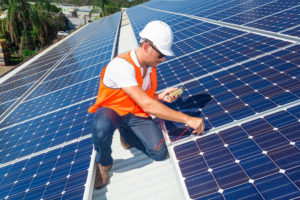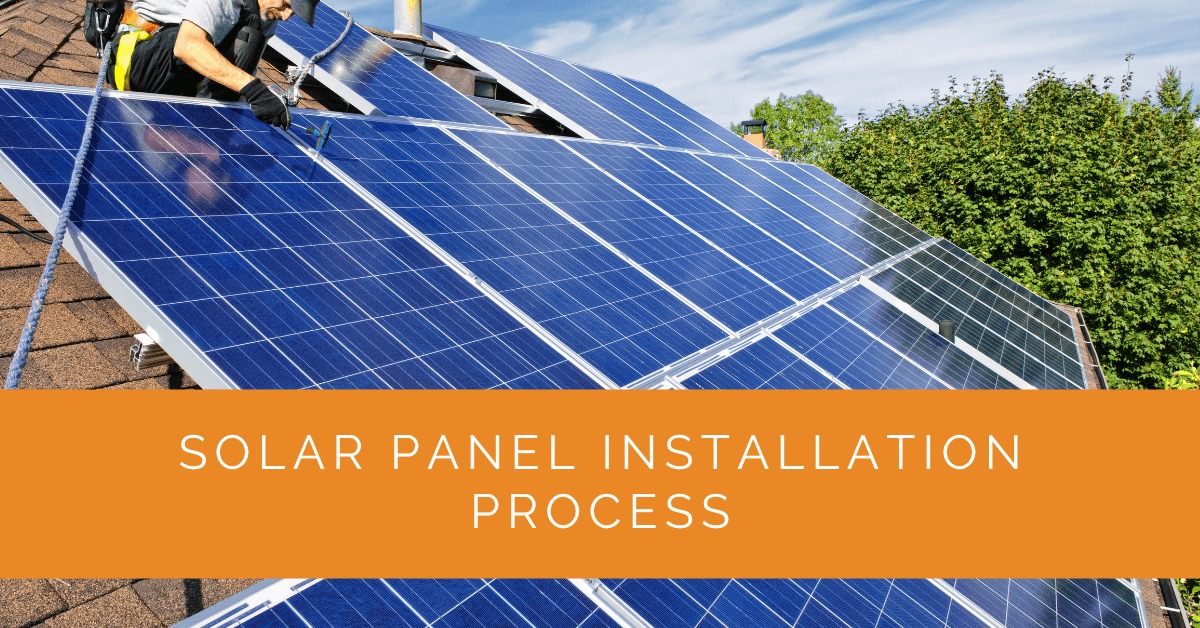In an era where sustainable energy is gaining momentum, installing solar panels is a wise choice for homeowners seeking clean and renewable energy solutions. This comprehensive guide will take you through the step-by-step process of installing a solar panel system on your roof, empowering you to go solar and embrace a greener future.
Contents
- 1 Step-by-Step Guide to the Solar Panel Installation Process
- 2 Step 1: System Design and Planning
- 3 Step 2: Obtaining Permits and Permissions
- 4 Step 3: Preparing the Installation Site
- 5 Step 4: Mounting and Installing the Panels
- 6 Step 5: Electrical Wiring and System Integration
- 7 Step 6: Inspection and Approval
- 8 Step 7: Activation and Monitoring
- 9 Case Study: Seamless Solar Panel Installation for a Sustainable Future
- 10 Expert Insights From Our Solar Panel Installers About Solar Panel Installation Process
- 11 Experience Solar Excellence with Us!
- 12 Conclusion
Step-by-Step Guide to the Solar Panel Installation Process
Step 1: System Design and Planning
System design and planning are the first crucial step in the solar panel installation process. During this stage, a professional solar installer will work closely with you to determine the optimal system design for your energy needs. They will assess factors such as your energy consumption patterns, available roof space, shading analysis, and local regulations.
The installer will use advanced software and tools to create a customized solar panel system design tailored to your home. This includes determining the number of solar panels required, their placement on the roof, the ideal tilt and orientation, and the type of inverter best suited for your system. The goal is to maximize energy production and system efficiency while considering aesthetics and specific site requirements.
To ensure accurate system design, the installer will conduct a comprehensive site survey, taking precise measurements, assessing roof conditions, and evaluating potential shading issues. By carefully analyzing all these factors, the installer can optimize your solar panel system for optimal performance and long-term savings.
Step 2: Obtaining Permits and Permissions
Before commencing the solar panel installation, obtaining the necessary permits and permissions from local authorities and homeowner associations is essential. These permits ensure compliance with building codes, safety standards, and zoning regulations.
Working with the solar installer, you will submit the required documentation and application forms to the relevant permitting authorities. The installer will provide detailed information about the proposed solar panel system, including structural engineering reports, electrical plans, and system specifications. These documents demonstrate that the installation meets all the requirements and poses no safety concerns.
Sometimes, you may also need to seek approval from your homeowner association. The installer will assist you in preparing the necessary documentation and ensuring compliance with any aesthetic guidelines or architectural restrictions. By engaging in this process early and working closely with the installer, you can navigate the permitting process smoothly and expedite the installation timeline.

Step 3: Preparing the Installation Site
Preparing the installation site is a critical aspect of solar panel installation, whether on the roof or ground-mounted. For roof-mounted systems, the installer will begin by conducting a thorough roof assessment to ensure its structural integrity and suitability for solar panels. Any necessary repairs, reinforcements, or roof replacements will be addressed before installation.
Next, the installer will determine the best locations for the solar panels based on factors such as available roof space, sun exposure, and shading analysis. Careful consideration will be given to ensure optimal energy production by minimizing shading from nearby structures, trees, or obstructions.
For ground-mounted systems, the installation site preparation involves clearing the area of vegetation, rocks, or debris. The ground will be leveled, and a stable foundation will be established for the solar panel array. This may involve installing concrete footings or ground screws to anchor the racking system securely.
Step 4: Mounting and Installing the Panels
With the installation site prepared, the next step is mounting and installing the solar panels. The installer will position and securely attach the racking system to the roof or ground. This racking system is the foundation for the solar panels and ensures their stability and durability.
Each solar panel will be carefully mounted onto the racking system, following the predetermined layout and orientation determined during the design phase. The installer will ensure proper alignment, spacing, and fastening of the panels to guarantee maximum energy production and longevity.
To maintain the integrity of your roof, the installer will employ appropriate techniques and sealants to prevent any water leakage. Great care will be taken to ensure that the mounting process does not compromise the roof’s structural integrity or pose any safety risks.
Step 5: Electrical Wiring and System Integration
The solar panel installation’s electrical wiring and system integration stage involves carefully connecting the solar panels, inverter, and electrical panel. This step requires the expertise of a qualified electrician to ensure the system operates safely and efficiently.
The installer will install the solar inverter, which converts the solar panels’ direct current (DC) electricity into usable alternating current (AC) electricity for your home. Depending on the system design and site conditions, the inverter may be installed near the electrical panel or in a central location.
The solar panels will be connected in a series or parallel configuration, depending on the design and electrical requirements of the system. The installer will carefully wire the panels together, ensuring proper polarity and minimizing voltage drop. All electrical connections will be securely made and protected with appropriate conduit and wiring techniques.
The solar panel system will be integrated with the existing electrical infrastructure of your home. The electrician will connect the inverter to the electrical panel, allowing the solar energy to supplement your household’s electrical supply. This integration ensures a seamless transition between solar power and grid power, enabling you to utilize clean, renewable energy while still having access to electricity when needed.
During this stage, safety measures such as grounding and surge protection will be implemented to safeguard the system and protect against electrical hazards. Compliance with local electrical codes and regulations is paramount to ensure the safety and reliability of the solar panel installation.

Step 6: Inspection and Approval
Once the solar panel system is fully installed and wired, it must undergo inspections by local authorities or utility companies to ensure compliance with safety and electrical standards. Inspections typically involve thoroughly reviewing the electrical connections, grounding, system design, and structural integrity.
The solar installer will coordinate the inspection process and ensure all required documentation, permits, and system specifications are readily available for review. It is essential to pass these inspections to obtain the necessary approval or permission to operate the solar panel system.
By passing inspections, you demonstrate that your solar panel installation meets all safety requirements and adheres to local regulations. This approval is a crucial step in ensuring your solar panel system’s reliability, performance, and longevity.
Step 7: Activation and Monitoring
With the inspections approved and all necessary permits obtained, your solar panel system is ready to be activated. The solar installer will work with you to commission the system and ensure it operates optimally.
During the activation process, the installer will perform comprehensive tests to verify that all components, including the solar panels, inverter, and electrical connections, are functioning correctly. If installed, they will also configure the monitoring system to track the energy production and performance of your solar panel system.
Monitoring allows you to closely monitor the system’s performance, energy generation, and energy usage. It provides valuable insights into the efficiency and effectiveness of your solar panel system. By monitoring your system regularly, you can identify potential issues or discrepancies and take appropriate actions to maintain its optimal performance.
In addition to self-monitoring, some solar panel systems offer remote monitoring capabilities, allowing you to access real-time data and performance metrics through a mobile app or web portal. This feature enables you to track your energy savings, monitor your environmental impact, and always stay connected to your solar panel system.
By actively monitoring your solar panel system, you can ensure its long-term reliability, identify any maintenance needs, and maximize the financial and environmental benefits of your investment in clean, renewable energy.
Case Study: Seamless Solar Panel Installation for a Sustainable Future
Background
At Solar Panels Network USA, we pride ourselves on delivering top-quality solar solutions tailored to each client’s unique needs. This case study showcases a residential solar panel installation where our expertise ensured a smooth and efficient transition to renewable energy.
Project Overview
The homeowner, seeking to reduce their carbon footprint and energy bills, approached us for a comprehensive solar solution. The project involved installing a solar panel system that maximized energy production while maintaining the aesthetics of their home. The process included system design, permitting, site preparation, installation, electrical integration, and final activation.
Implementation
System Design and Planning
- Initial Consultation and Assessment: Our team began with an in-depth consultation to understand the homeowner’s energy needs and goals. We conducted a thorough site survey, assessing roof space, orientation, and potential shading issues. Using advanced software, we designed a customized solar panel system that balanced efficiency and visual appeal.
- Customized System Design: We determined the optimal number of panels, their placement, and the ideal inverter type. The design aimed to maximize sunlight exposure and energy production. Detailed plans, including structural and electrical specifications, were prepared to ensure compliance with local regulations and to facilitate the permitting process.
- Obtaining Permits and Permissions: Navigating the permitting landscape can be challenging, but our experience streamlined the process. We compiled all necessary documentation, including engineering reports and system specifications, and submitted the permit applications to local authorities and the homeowner association. Our proactive approach ensured a quick approval, keeping the project on schedule.
Preparing the Installation Site
- Roof Assessment and Preparation:Before installation, we performed a comprehensive roof assessment. Necessary repairs and reinforcements were made to ensure the roof could support the solar panels. We also cleared any potential obstructions that could impact solar efficiency.
- Site Preparation for Ground-Mounted Systems: For homes with additional ground-mounted solar panels, the site was cleared, leveled, and prepared with a stable foundation. This preparation was crucial to ensure the long-term durability and stability of the solar array.
Mounting and Installing the Panels
- Mounting the Racking System: With the site ready, we installed the racking system, ensuring it was securely anchored to the roof and ground. This framework provided a sturdy base for the solar panels.
- Panel Installation: Each panel was carefully mounted onto the racking system. Our team ensured precise alignment and secure fastening to optimize energy production. Special care was taken to maintain the roof’s integrity, preventing any potential leaks or damage.
Electrical Wiring and System Integration
- Inverter Installation: The inverter, a critical component converting DC to AC power, was installed in an optimal location for accessibility and efficiency. Our certified electricians handled all electrical connections, ensuring compliance with safety standards.
- System Integration: The solar panels were wired in series and parallel configurations as per the design specifications. The system was integrated with the home’s electrical infrastructure, enabling seamless transition and usage of solar power.
Inspection and Approval
- Local Authority Inspections: After installation, local authorities conducted thorough inspections. Our meticulous preparation ensured that the system met all safety and code requirements, resulting in swift approval.
- Final Checks: We performed comprehensive tests to ensure every component functioned correctly. The system was activated, and the monitoring setup was configured to provide real-time performance data.
Activation and Monitoring
- System Activation: Upon receiving all necessary approvals, we activated the solar panel system. The homeowner was guided through the system’s features and monitoring tools.
- Ongoing Monitoring and Support: The monitoring system allowed the homeowner to track energy production and usage. We provided ongoing support to ensure optimal performance, addressing any issues promptly to maximize efficiency and savings.
Summary
This project exemplifies the expertise and dedication of Solar Panels Network USA in delivering tailored solar solutions. By meticulously planning, securing permits, preparing the site, and executing the installation, we ensured a seamless transition to renewable energy for the homeowner. The result was a highly efficient solar panel system that reduced energy bills and contributed to a sustainable future.
Expert Insights From Our Solar Panel Installers About Solar Panel Installation Process
Proper system design and planning are crucial to maximize the efficiency and output of your solar panel system. Every detail, from roof angle to shading analysis, matters in ensuring you get the most out of your investment.
Lead Solar Installer
Obtaining the necessary permits can be a tedious process, but it ensures that your solar installation complies with local regulations and safety standards. A smooth permitting process sets the foundation for a successful installation.
Senior Solar Project Manager
Activation and monitoring of the solar panel system are essential to ensure that it operates efficiently from day one. Regular monitoring helps in early detection of issues and ensures optimal performance.
Solar Energy Specialist
Experience Solar Excellence with Us!
Trust in Solar Panels Network USA, where our seasoned experts deliver top-quality solar solutions for homes and businesses nationwide. With a legacy of countless successful installations and a commitment to sustainable energy, we’re your reliable partner in the solar journey. Ready for a brighter, eco-friendly future? Call us now at (855) 427-0058 and harness the power of the sun!
Conclusion
The solar panel installation process is a transformative journey toward a more sustainable and energy-efficient future. By embracing clean energy through solar power, you reduce carbon emissions, lower energy bills, and achieve greater energy independence.
Each step of the installation process, from system design and obtaining permits to mounting the panels and integrating the electrical components, plays a vital role in ensuring the successful implementation of your solar panel system. Working with a reputable solar installer who understands the intricacies of the process ensures that your system is designed, installed, and connected properly to maximize performance and longevity.
Not only does solar panel installation offer environmental benefits, but it also provides significant financial advantages. By generating your clean energy, you can reduce your reliance on traditional grid power, leading to substantial savings on energy bills over the system’s lifespan. Additionally, various financing options, incentives, and tax credits may be available to make solar panel installation more affordable and accessible.
By embracing solar power and installing solar panels, you actively participate in the global shift towards renewable energy. You contribute to advancing clean technologies, reducing dependence on fossil fuels, and creating a greener and more sustainable world for future generations. Take the leap, choose solar, and join the growing community of homeowners making a positive impact through solar panel installation.
Embrace the sun’s power, invest in solar energy, and unlock the numerous benefits of a solar panel system. Experience the joy of clean, renewable energy while enjoying long-term financial savings and the satisfaction of reducing your carbon footprint. Solar panel installation is a transformative step towards a brighter, more sustainable future for you, your home, and the planet.
About the Author
Solar Panels Network USA stands at the forefront of solar energy solutions, driven by a team of seasoned solar engineers and energy consultants. With over decades of experience in delivering high-quality solar installations and maintenance, we are committed to promoting sustainable energy through customer-centric, tailored solutions. Our articles reflect this commitment, crafted collaboratively by experts to provide accurate, up-to-date insights into solar technology, ensuring our readers are well-informed and empowered in their solar energy decisions.

